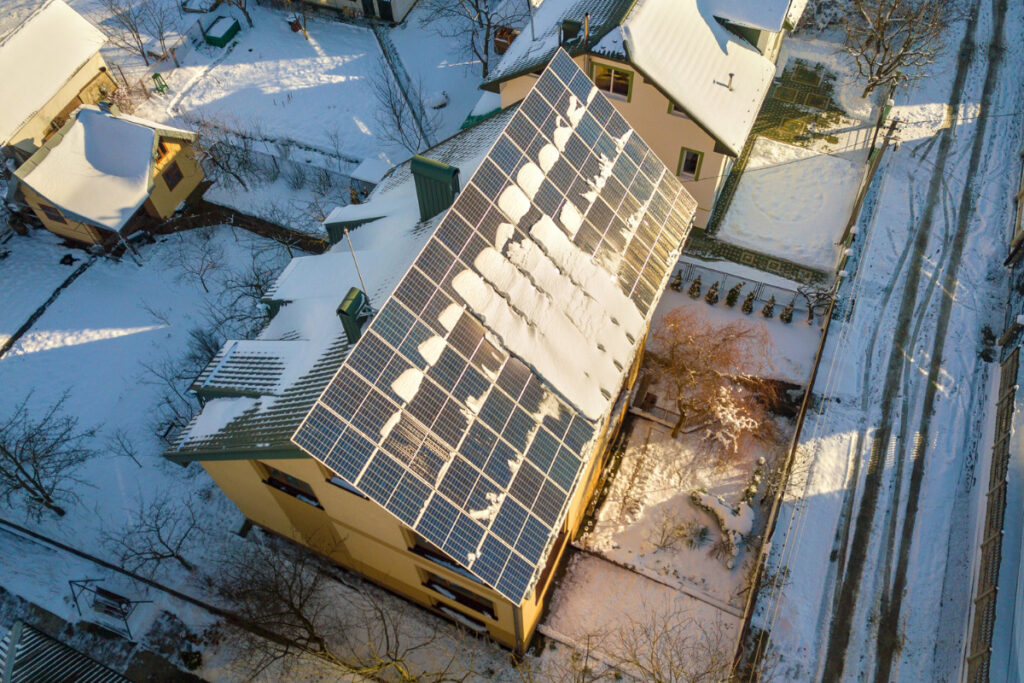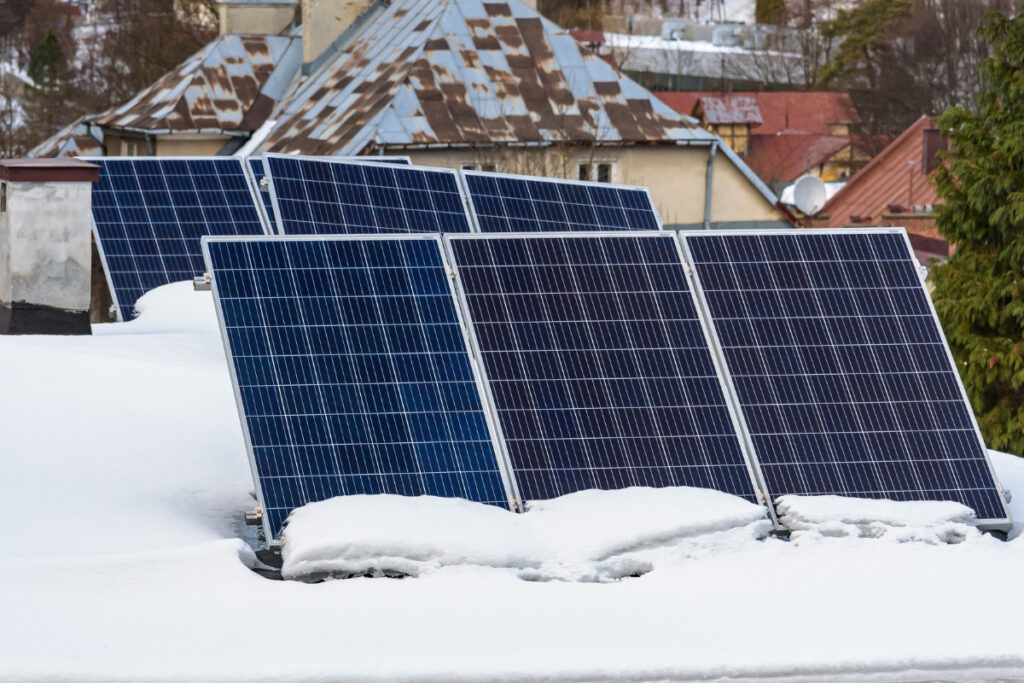Introduction
As winter rolls in with its sub-freezing temperatures, many homeowners question their solar panels’ efficiency. Can these clean energy powerhouses generate enough electricity under icy and snowy conditions? In this informative blog post, we’re debunking myths and unlocking the truth about solar panels‘ performance during harsh cold weather.
| Key Takeaways |
|---|
| Solar panels can still generate power in sub-freezing temperatures, despite common misconceptions. |
| Cold temperatures may actually increase the efficiency of solar panels due to increased conductivity of silicone. |
| Factors such as insulation, panel orientation and positioning, regular maintenance and cleaning, and innovative solutions like anti-reflective coatings are all crucial for maximizing output in cold weather conditions. |
| Investing in efficient solar panel systems designed for harsh environments can ensure optimal performance year-round. |
The Science Of Solar Panels In Cold Weather
Photovoltaic cells made up of layers of semi-conducting materials, convert sunlight into electricity. When exposed to sunlight, these cells allow electrons to flow through them, enabling solar panels to work and generate electricity.
How Solar Panels Convert Sunlight Into Electricity
Solar panels harness the power of sunlight by using a technology known as photovoltaic (PV) cells. These PV cells are made of semiconductor materials, such as silicon, which have unique properties that allow them to generate electricity when exposed to sunlight.
As light strikes the surface of a solar panel, photons from the sun’s rays interact with electrons within the cell material.
The process begins with sunlight passing through an anti-reflective layer on the solar panel before reaching the PV cell. Once there, it activates negatively-charged particles in the semiconductors causing them to move toward positively-charged particles in a separate area within each individual PV cell.
The flow of these charged particles forms an electrical circuit that generates direct current (DC) electricity.
For example, imagine a homeowner installing solar panels on their rooftop to reduce their dependency on grid-supplied energy sources; they will witness firsthand how these highly efficient systems can convert sunlight into usable electricity throughout various weather conditions all year round.
The Relationship Between Temperature And Efficiency
Solar panels rely on sunlight to generate electricity, but the temperature also affects their efficiency. As the temperature drops, solar panel efficiency typically decreases as well.
This decrease is due to the photovoltaic effect, which causes electrons to move more slowly when temperatures are colder. However, this decrease is often minimal and does not affect overall energy production significantly.
In fact, some studies have shown that solar panels can actually perform better in cold temperatures compared to scorching ones.
Dispelling Misconceptions About Solar Panels In Sub-Freezing Temperatures
It is a common misconception that solar panels do not work in sub-freezing temperatures. However, this is far from the truth. Here are some facts to dispel the myths surrounding solar panel efficiency in cold weather:
- Solar panels generate electricity when sunlight hits them, regardless of the temperature outside.
- Researchers have shown solar panels can generate electricity in snowy and harsh environments.
- Cold temperatures can help solar production as colder temperatures increase silicone conductivity, enhancing photovoltaic efficiency.
- Solar panels are designed to shed snow and continue producing electricity, ensuring minimal loss of energy output during inclement weather.
- Although snow and ice accumulation can affect performance, regular maintenance and cleaning can help maintain optimal performance levels.
- There is no significant difference in solar panel output between winter and summer if properly positioned and oriented.
- Solar panels are built with materials to withstand extreme temperatures, including freezing conditions.
So, if solar panels are correctly installed and regularly maintained, it is clear that sub-freezing temperatures do not affect their ability to generate electricity. Therefore, investing in efficient solar panel systems remains viable for renewable energy production even in areas with harsh winter weather conditions.
Factors Affecting Solar Panels In Cold Weather
Factors that can affect solar panels in cold weather include insulation and airflow, the angle and orientation of the panels, as well as snow and ice accumulation on the surface.
Insulation And Air Flow
Insulation and air flow are crucial in optimizing solar panel performance during sub-freezing temperatures. Good insulation helps prevent heat loss and stabilize the solar panel’s temperature. Meanwhile, proper airflow ensures that heat is evenly distributed.
Insulation can be achieved through foam or fiberglass batting installed behind the panels, preventing heat loss from escaping outwards. On the other hand, airflow can make a significant difference in how efficiently your solar panels function during cold weather conditions.
Another important factor in insulation and airflow is considering the wind chill factor. This factor may significantly impact energy production, especially for communities near water bodies with more humidity. The humidity level can affect overall weather patterns, causing extreme temperatures and increasing the demand for cooling systems like HVACs. It is equally smart to have professionals evaluate climate changes and install optimized Solar Panel Systems. Proper insulation prevents heat loss and stabilizes the temperature of the solar panel. It can be achieved by installing materials like foam or fiberglass batting behind the panels to prevent heat from escaping outwards. Additionally, ensuring proper airflow helps evenly distribute the heat.
Angle And Orientation Of Solar Panels
The angle and orientation of solar panels play a crucial role in maximizing their performance, especially in cold weather conditions. The best tip for solar panels is usually between 30 to 45 degrees relative to the ground, depending on the latitude of the installation site.
In addition to angle, orientation also plays a key role. Solar panels should ideally face south to maximize exposure to sunlight. However, east or west-facing orientations can still generate significant amounts of electricity during certain times of the day.
Correct panel positioning can significantly boost efficiency even during sub-freezing and snowy conditions.
Snow And Ice Accumulation
Snow and ice accumulation on solar panels can impact their performance in cold weather. If snow builds up on a panel, it can block sunlight from reaching the photovoltaic cells.
This reduces electricity generation. However, most solar panels are designed with a sloping surface that helps shed snow and ice.
To further enhance the efficiency of solar panels during winter months, some people opt for anti-reflective coatings that minimize snow buildup and maximize light absorption by reducing glare from shiny surfaces.
Despite these challenges posed by snowy conditions in cold weather climates, solar power is still an efficient means of renewable energy production year-round when properly maintained and optimized for maximum output regardless of temperature extremes.
Maximizing Solar Panel Performance In Cold Weather
To maximize solar panel performance in cold weather, regular maintenance and cleaning, anti-reflective coatings, investing in efficient solar panel systems, correct panel orientation and optimal positioning, and innovative solutions for cold-weather conditions are recommended.
Regular Maintenance And Cleaning
Regular maintenance and cleaning are vital to ensure the optimal performance of solar panels in sub-freezing temperatures. Here are some essential maintenance tasks to consider:
- Check for damage: Inspect the solar panels regularly for any physical damage, such as cracks or other signs of wear and tear caused by harsh weather conditions.
- Clean the panels: Dirt, dust, and debris can accumulate on solar panels over time, reducing efficiency. Regularly clean the panels using a soft brush, sponge, and warm water to remove any accumulated debris.
- Remove snow: If snow accumulates on solar panels, it can reduce their ability to capture sunlight. Clearing snow from the surface of the panels can help improve their efficiency.
- Keep an eye on performance: Regularly monitor the performance of your solar panels to ensure that they generate electricity at maximum capacity.
- Hire a professional: If you’re uncomfortable performing maintenance independently, consider hiring a professional to inspect and service your solar panel system.
By keeping up with regular maintenance tasks like these, you can help ensure that your solar panel system continues to generate electricity efficiently throughout the winter months.
Use Of Anti-Reflective Coatings
One can apply anti-reflective coatings to the panels to maximize solar panel performance in cold weather. These coatings reduce reflection, allowing the panels to absorb more sunlight. As a result, the efficiency and output of the panels are increased.
For example, a study conducted by Stanford University found that applying an anti-reflection coating to silicon solar cells increased their power conversion efficiency by 3.6 percent in winter compared to uncoated cells.
Anti-reflective coatings are just one way to enhance solar panel performance in sub-freezing temperatures; ensuring correct orientation and positioning, regular cleaning, and innovative solutions tailored to extreme climates can help overcome challenges faced by cold weather conditions.
Investing In Efficient Solar Panel Systems
Investing in efficient solar panel systems is one of the key ways to maximize solar panel performance in sub-freezing temperatures. This includes selecting high-quality solar panels with advanced technologies designed to withstand harsh environments and deliver optimal efficiency even when snowing or freezing outside.
Another way to boost the efficiency of your solar system is by investing in a battery backup system that can store excess energy generated during sunny hours for use during darker winter days.
Regular maintenance and cleaning are also essential for keeping your solar panels working efficiently, including removing any snow buildup or debris that may accumulate on them.
Correct Panel Orientation And Optimal Positioning
Correct panel orientation and optimal positioning of solar panels are essential for maximizing their efficiency in sub-freezing temperatures. Here are some ways to ensure the proper orientation and positioning of solar panels:
– The angle of the solar panel should be adjusted based on the latitude of the location to maximize exposure to sunlight.
– To get maximum exposure to sunlight, position the panels facing south in the Northern Hemisphere or north in the Southern Hemisphere.
– Ensure that no trees, buildings, or other objects block sunlight from reaching the panels.
– If possible, tilt solar panels slightly towards the sun during winter months to optimize sunlight intake.
– Keep solar panels clean and free from snow, debris, and ice buildup.
Proper orientation and positioning will help generate more electricity even in low-temperature conditions. These panels are typically equipped with anti-reflective coatings, which help absorb more sunlight. Additionally, they’re engineered to resist snow and ice accumulation.
Innovative Solutions For Cold-Weather Conditions
Investing in solar panels designed specifically for cold weather conditions is one way to maximize their performance. These panels are typically equipped with anti-reflective coatings, which help absorb more sunlight. Additionally, they’re engineered to resist snow and ice accumulation.
Regular maintenance and cleaning can also help improve solar panel efficiency during winter. This includes removing any snow or debris from the surface of the panels, which can block sunlight absorption.
New technologies like micro-inverters and power optimizers can significantly improve energy production even during cloudy or low-light conditions.
Solar technology continues evolving, with enhanced performance features being developed yearly. This is to meet the ever-growing demand for renewable energy sources.
Conclusion: The Viability Of Solar Panels In Sub-Freezing Temperatures
In conclusion, the idea that solar panels cannot generate power in sub-freezing temperatures is a myth. Even though cold and snowy conditions can affect their performance, solar panels are designed to work efficiently in harsh environments.
Factors such as insulation, correct orientation and positioning, and regular maintenance are all crucial to maximize their output. With innovative solutions like anti-reflective coatings being introduced, it’s clear that research into improving solar panel efficiency is ongoing.
Going solar?
Are you considering solar energy for your home, even during the colder winter? Let DroneQuote assist you in deciding the ideal solar panel type and quantity tailored to your specific needs. We provide honest feedback on whether investing in solar is the right choice for you. Our expert team will guide and help you maintain the highest efficiency of your solar panels, even during colder months. Start maximizing your energy savings and reducing your carbon footprint today with DroneQuote!
FAQs
- Can solar panels still function in sub-freezing temperatures?
Yes, as long as solar panels are exposed to sunlight, they can still generate power in sub-freezing temperatures. However, extreme temperature changes and ice buildup on the panels can affect their efficiency and output.
- Do I need to take any special precautions if using solar panels in cold climates?
If you live in a colder climate, experts recommend installing your solar panels at an angle. This ensures that snow and ice will slide off naturally. Additionally, you should regularly remove any accumulation of snow or ice from the surface of your panel. This helps prevent damage and maintains maximum energy production.
- How do low temperatures impact the efficiency of my solar panel system?
When temperatures drop significantly, some energy loss is expected. This is due to resistance caused by the lower conductivity of materials used for wiring connections between modules. Additionally, reduced sunlight exposure during winter months may lead to a decrease in overall power production compared with summer months. However, this variation depends on geographic location and environmental factors such as regional weather patterns and cloud cover.
- Can I use my existing solar panel system during winter seasons without problems?
Most modern systems, including winters, are designed to operate efficiently during all seasons. However, it is important to take certain precautions, particularly when there is potential for snow or ice accumulation. It’s important to keep regular maintenance checks scheduled. This ensures that proper orientation/tilt has been set up properly. It means all parts are functioning correctly before extreme cold hits!



